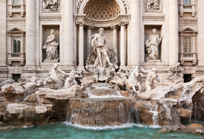Beyond Baroque
November 23, 2011
0
Shares

 When I first began organizing these “Travelogues†several months ago, my sincere intention was to focus on watershapes found within the United States. Partly it was a gesture to the restricted travel budgets of modern times, but I also wanted to highlight the fact thatthis country boasts many watershapes well worth a pilgrimage.
When I first began organizing these “Travelogues†several months ago, my sincere intention was to focus on watershapes found within the United States. Partly it was a gesture to the restricted travel budgets of modern times, but I also wanted to highlight the fact thatthis country boasts many watershapes well worth a pilgrimage.But I had to make some exceptions, including this one: I was speaking with a friend who’d just returned from Rome, and she reported being less than inspired by her visit to Trevi Fountain – a thought that made me feel obliged to speak up here in its defense.
The fountain had noble origins. At first, it was a public wellhead at the end of a Roman aqueduct and mainly had the distinction of feeding the nearby Baths of Agrippa. It served the city with distinction for several centuries before the Goths destroyed the aqueduct (thereby rendering the original fountain useless) in the invasions that led to the fall of the Roman Empire in the 6th Century.
During the Renaissance, the aqueduct was restored and in 1453 Pope Nicholas V enlisted the architect Leon Battista Alberti to design a simple basin to complete the system. This solution was too plain for subsequent tastes, and even the great Bernini took a shot at redesigning it (never past the drawing stage) before, in 1732, Nicola Salvi won a design competition and began work almost immediately.
Salvi died in 1751 with the project incomplete. Others finished the fountain based on his plans, and it was ready by 1762 to assume its place as a masterpiece of Baroque design.
When I first visited Trevi Fountain myself back in 1977, I thought it was a bit too gaudy and over the top for its own good. But I remember its sounds, cooling effect and artful details, and to this day appreciate its massive perfections, so much so that I have urged everyone I know who is planning a trip to Rome to visit it twice – once early in the morning and again early in the evening.
To see a video of the fountain in action, click here. Wonderful, if you can endure the guy with the hat!









